A Report on 3D Printing: Technology, Applications, and Future Trends
VerifiedAdded on 2020/05/03
|9
|1757
|98
Report
AI Summary
This report provides an introduction to 3D printing, also known as additive manufacturing, and its significant impact on various industries. It explores the technology's role in low-cost production and its advantages over traditional manufacturing methods, such as the ability to change design concepts quickly and efficiently. The report delves into suitable situations for 3D printing, highlighting its applications in medical fields, product design, and personal fabrication. It also discusses the future of 3D printing, including its potential for direct digital manufacturing, mass commercialization, and applications in aviation and construction. The report concludes by summarizing the impact of 3D printing on traditional manufacturing, emphasizing implications for assembly lines and pricing strategies. Overall, the report emphasizes the transformative potential of 3D printing in revolutionizing manufacturing techniques, offering cost savings, and enabling innovative design processes.
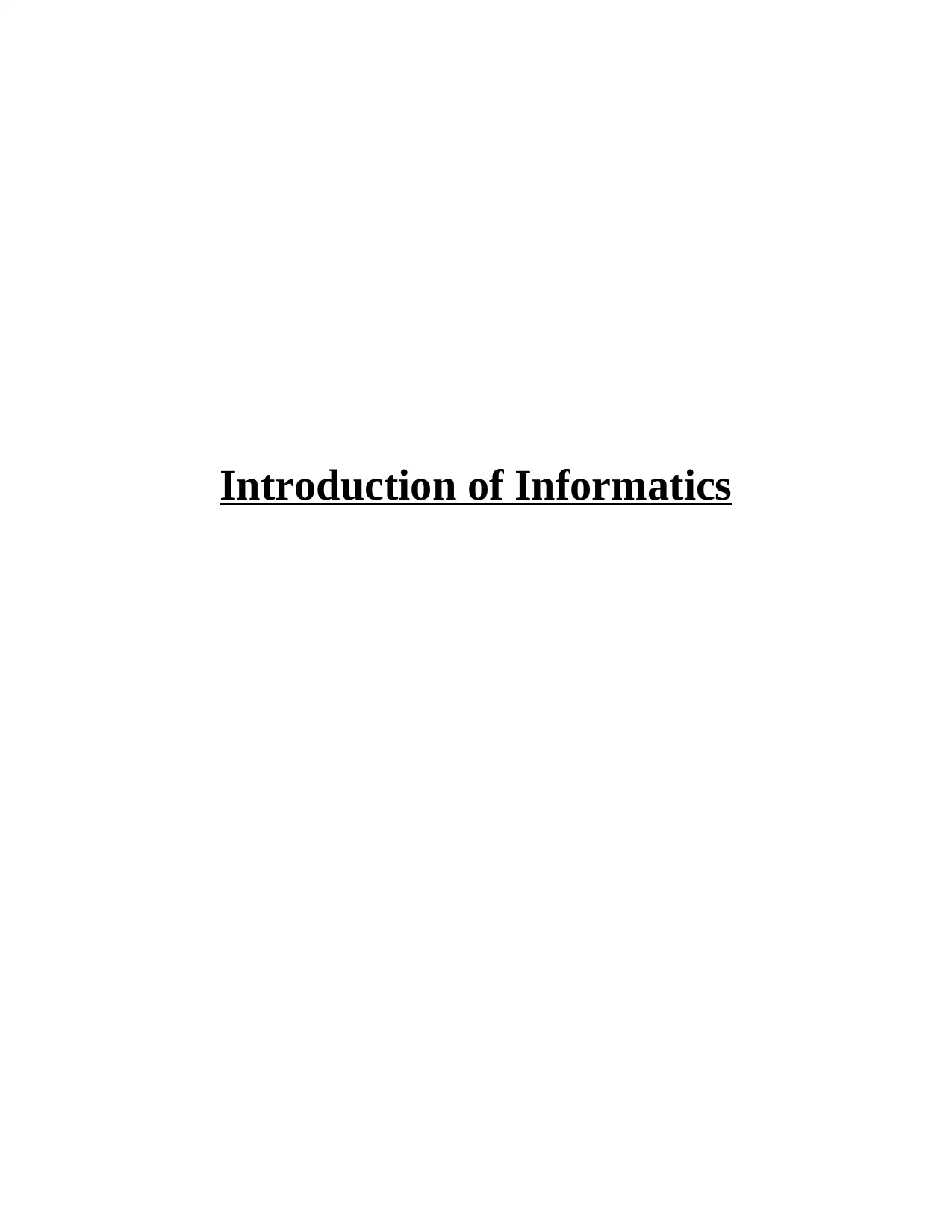
Introduction of Informatics
Paraphrase This Document
Need a fresh take? Get an instant paraphrase of this document with our AI Paraphraser
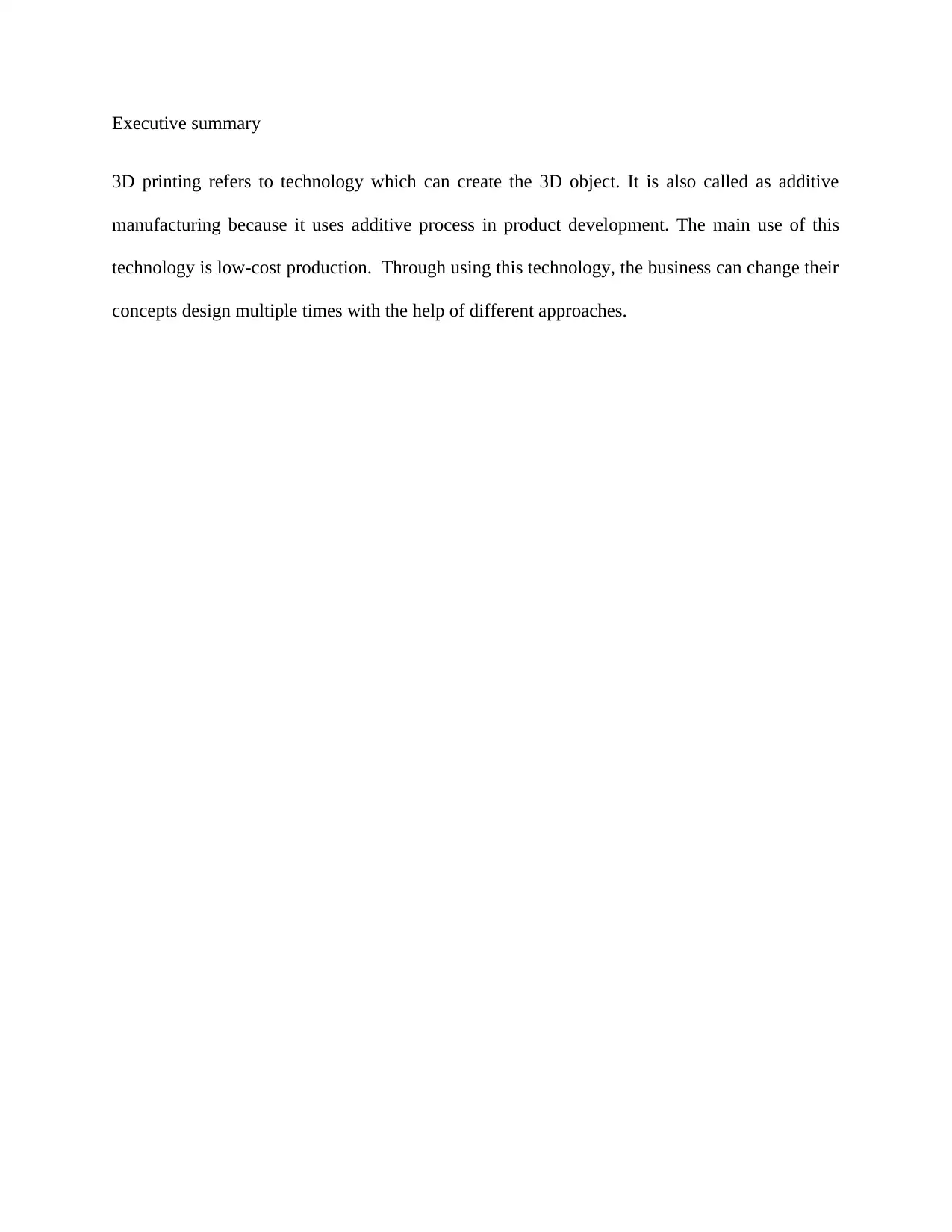
Executive summary
3D printing refers to technology which can create the 3D object. It is also called as additive
manufacturing because it uses additive process in product development. The main use of this
technology is low-cost production. Through using this technology, the business can change their
concepts design multiple times with the help of different approaches.
3D printing refers to technology which can create the 3D object. It is also called as additive
manufacturing because it uses additive process in product development. The main use of this
technology is low-cost production. Through using this technology, the business can change their
concepts design multiple times with the help of different approaches.
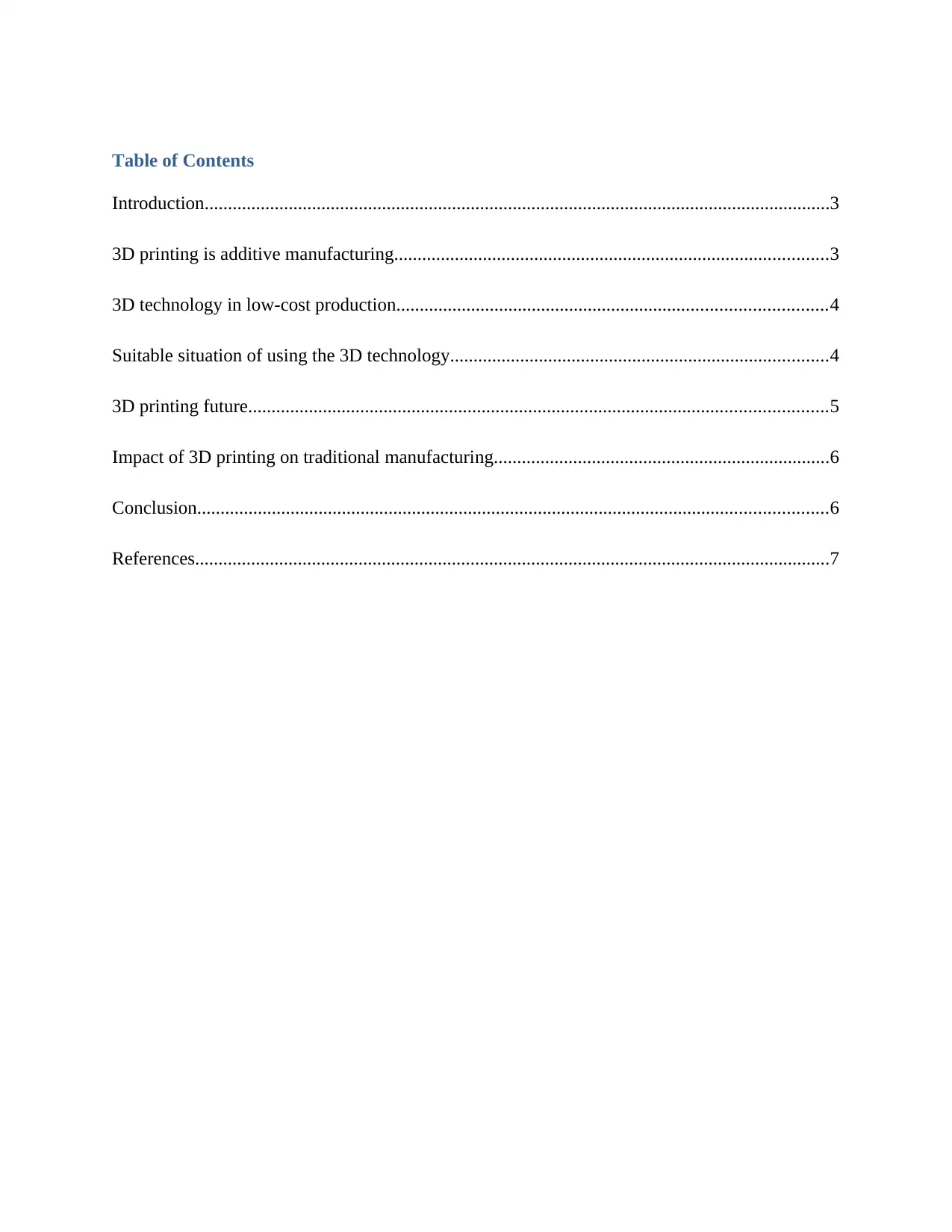
Table of Contents
Introduction......................................................................................................................................3
3D printing is additive manufacturing.............................................................................................3
3D technology in low-cost production............................................................................................4
Suitable situation of using the 3D technology.................................................................................4
3D printing future............................................................................................................................5
Impact of 3D printing on traditional manufacturing........................................................................6
Conclusion.......................................................................................................................................6
References........................................................................................................................................7
Introduction......................................................................................................................................3
3D printing is additive manufacturing.............................................................................................3
3D technology in low-cost production............................................................................................4
Suitable situation of using the 3D technology.................................................................................4
3D printing future............................................................................................................................5
Impact of 3D printing on traditional manufacturing........................................................................6
Conclusion.......................................................................................................................................6
References........................................................................................................................................7
⊘ This is a preview!⊘
Do you want full access?
Subscribe today to unlock all pages.

Trusted by 1+ million students worldwide
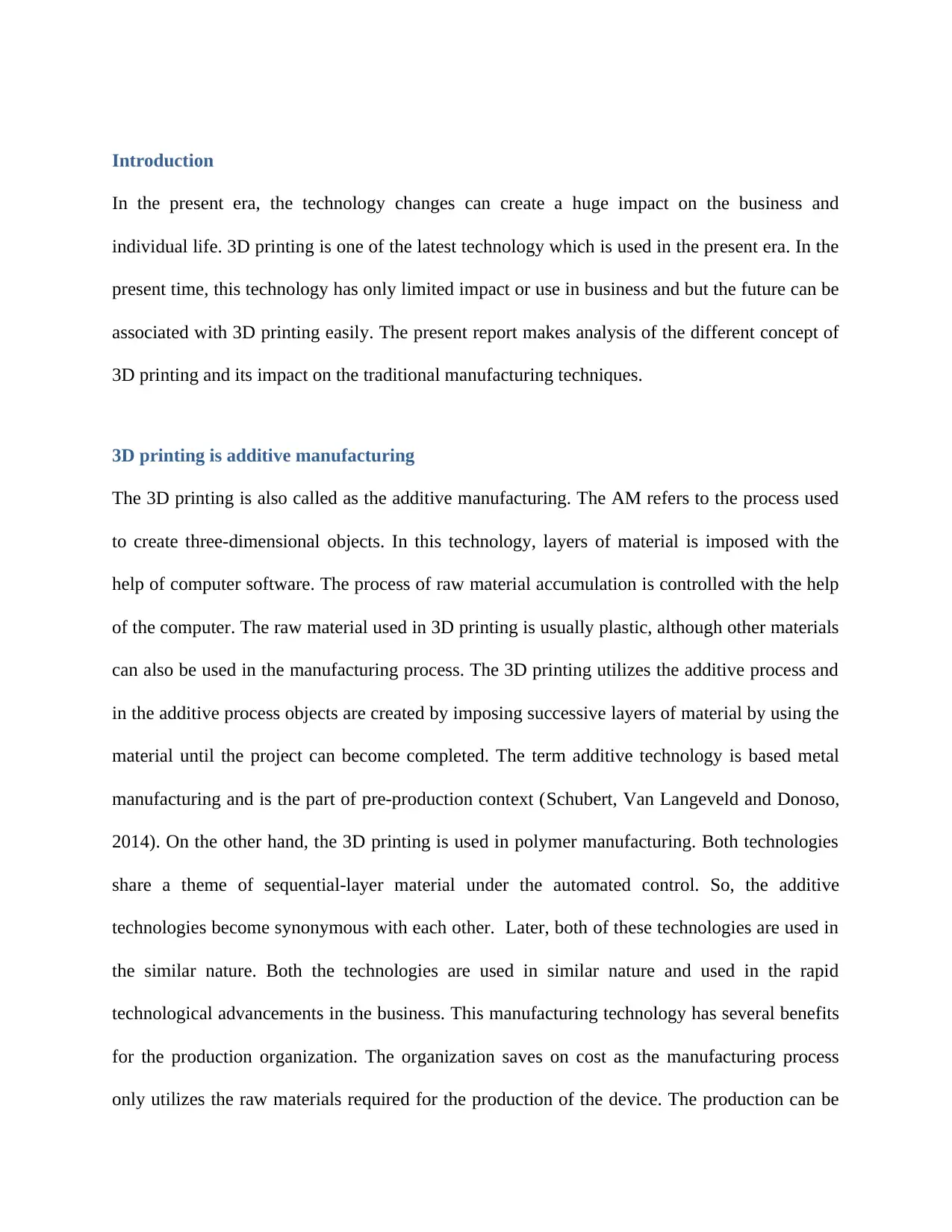
Introduction
In the present era, the technology changes can create a huge impact on the business and
individual life. 3D printing is one of the latest technology which is used in the present era. In the
present time, this technology has only limited impact or use in business and but the future can be
associated with 3D printing easily. The present report makes analysis of the different concept of
3D printing and its impact on the traditional manufacturing techniques.
3D printing is additive manufacturing
The 3D printing is also called as the additive manufacturing. The AM refers to the process used
to create three-dimensional objects. In this technology, layers of material is imposed with the
help of computer software. The process of raw material accumulation is controlled with the help
of the computer. The raw material used in 3D printing is usually plastic, although other materials
can also be used in the manufacturing process. The 3D printing utilizes the additive process and
in the additive process objects are created by imposing successive layers of material by using the
material until the project can become completed. The term additive technology is based metal
manufacturing and is the part of pre-production context (Schubert, Van Langeveld and Donoso,
2014). On the other hand, the 3D printing is used in polymer manufacturing. Both technologies
share a theme of sequential-layer material under the automated control. So, the additive
technologies become synonymous with each other. Later, both of these technologies are used in
the similar nature. Both the technologies are used in similar nature and used in the rapid
technological advancements in the business. This manufacturing technology has several benefits
for the production organization. The organization saves on cost as the manufacturing process
only utilizes the raw materials required for the production of the device. The production can be
In the present era, the technology changes can create a huge impact on the business and
individual life. 3D printing is one of the latest technology which is used in the present era. In the
present time, this technology has only limited impact or use in business and but the future can be
associated with 3D printing easily. The present report makes analysis of the different concept of
3D printing and its impact on the traditional manufacturing techniques.
3D printing is additive manufacturing
The 3D printing is also called as the additive manufacturing. The AM refers to the process used
to create three-dimensional objects. In this technology, layers of material is imposed with the
help of computer software. The process of raw material accumulation is controlled with the help
of the computer. The raw material used in 3D printing is usually plastic, although other materials
can also be used in the manufacturing process. The 3D printing utilizes the additive process and
in the additive process objects are created by imposing successive layers of material by using the
material until the project can become completed. The term additive technology is based metal
manufacturing and is the part of pre-production context (Schubert, Van Langeveld and Donoso,
2014). On the other hand, the 3D printing is used in polymer manufacturing. Both technologies
share a theme of sequential-layer material under the automated control. So, the additive
technologies become synonymous with each other. Later, both of these technologies are used in
the similar nature. Both the technologies are used in similar nature and used in the rapid
technological advancements in the business. This manufacturing technology has several benefits
for the production organization. The organization saves on cost as the manufacturing process
only utilizes the raw materials required for the production of the device. The production can be
Paraphrase This Document
Need a fresh take? Get an instant paraphrase of this document with our AI Paraphraser
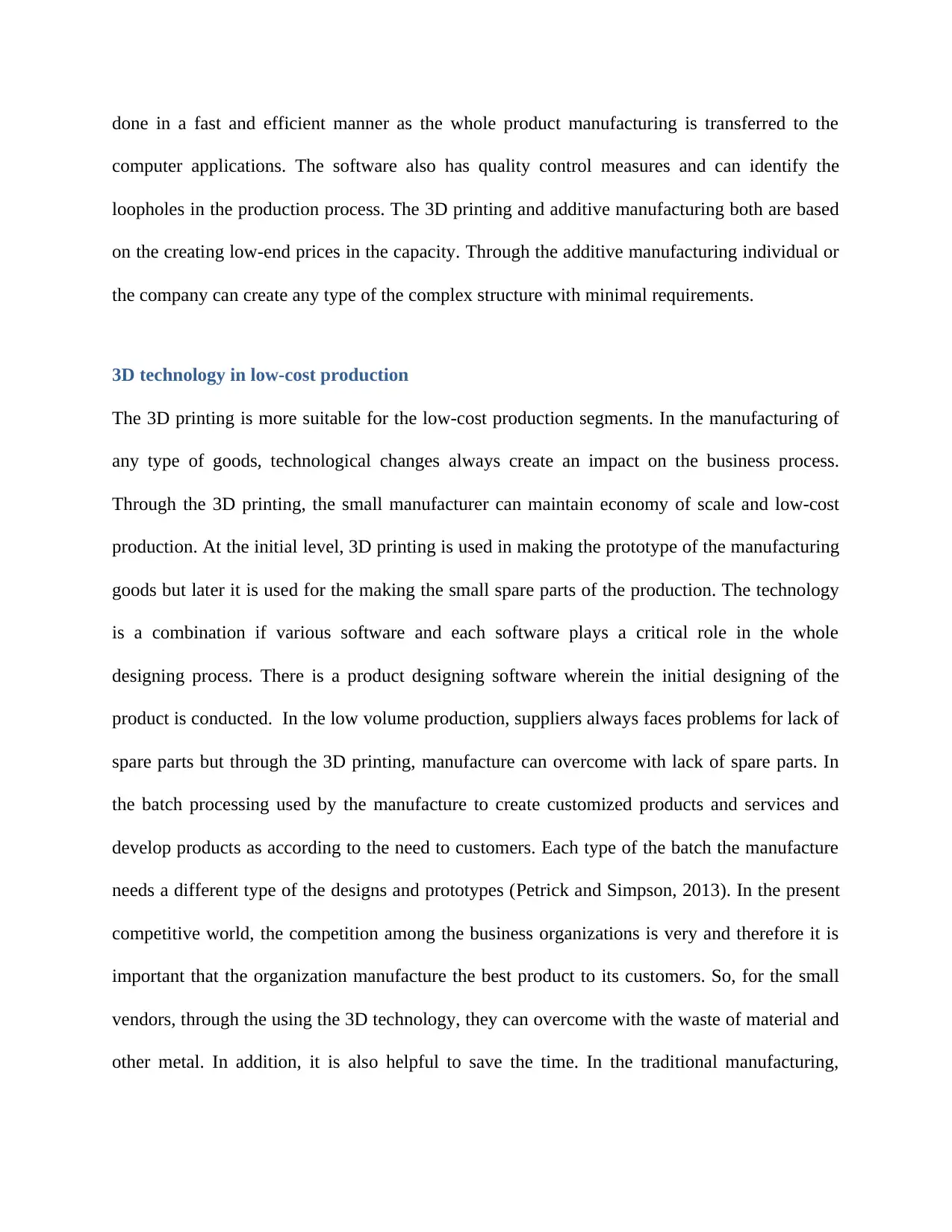
done in a fast and efficient manner as the whole product manufacturing is transferred to the
computer applications. The software also has quality control measures and can identify the
loopholes in the production process. The 3D printing and additive manufacturing both are based
on the creating low-end prices in the capacity. Through the additive manufacturing individual or
the company can create any type of the complex structure with minimal requirements.
3D technology in low-cost production
The 3D printing is more suitable for the low-cost production segments. In the manufacturing of
any type of goods, technological changes always create an impact on the business process.
Through the 3D printing, the small manufacturer can maintain economy of scale and low-cost
production. At the initial level, 3D printing is used in making the prototype of the manufacturing
goods but later it is used for the making the small spare parts of the production. The technology
is a combination if various software and each software plays a critical role in the whole
designing process. There is a product designing software wherein the initial designing of the
product is conducted. In the low volume production, suppliers always faces problems for lack of
spare parts but through the 3D printing, manufacture can overcome with lack of spare parts. In
the batch processing used by the manufacture to create customized products and services and
develop products as according to the need to customers. Each type of the batch the manufacture
needs a different type of the designs and prototypes (Petrick and Simpson, 2013). In the present
competitive world, the competition among the business organizations is very and therefore it is
important that the organization manufacture the best product to its customers. So, for the small
vendors, through the using the 3D technology, they can overcome with the waste of material and
other metal. In addition, it is also helpful to save the time. In the traditional manufacturing,
computer applications. The software also has quality control measures and can identify the
loopholes in the production process. The 3D printing and additive manufacturing both are based
on the creating low-end prices in the capacity. Through the additive manufacturing individual or
the company can create any type of the complex structure with minimal requirements.
3D technology in low-cost production
The 3D printing is more suitable for the low-cost production segments. In the manufacturing of
any type of goods, technological changes always create an impact on the business process.
Through the 3D printing, the small manufacturer can maintain economy of scale and low-cost
production. At the initial level, 3D printing is used in making the prototype of the manufacturing
goods but later it is used for the making the small spare parts of the production. The technology
is a combination if various software and each software plays a critical role in the whole
designing process. There is a product designing software wherein the initial designing of the
product is conducted. In the low volume production, suppliers always faces problems for lack of
spare parts but through the 3D printing, manufacture can overcome with lack of spare parts. In
the batch processing used by the manufacture to create customized products and services and
develop products as according to the need to customers. Each type of the batch the manufacture
needs a different type of the designs and prototypes (Petrick and Simpson, 2013). In the present
competitive world, the competition among the business organizations is very and therefore it is
important that the organization manufacture the best product to its customers. So, for the small
vendors, through the using the 3D technology, they can overcome with the waste of material and
other metal. In addition, it is also helpful to save the time. In the traditional manufacturing,
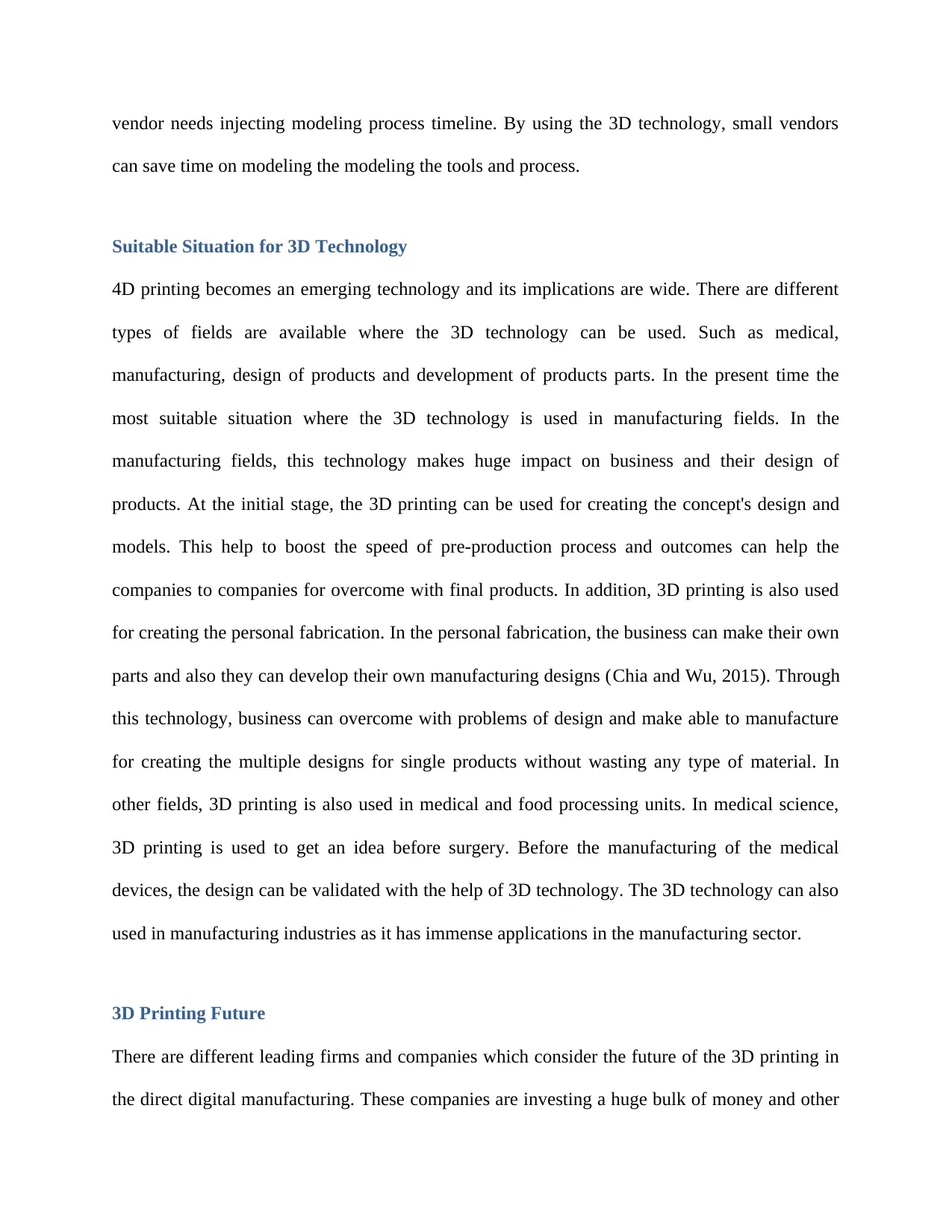
vendor needs injecting modeling process timeline. By using the 3D technology, small vendors
can save time on modeling the modeling the tools and process.
Suitable Situation for 3D Technology
4D printing becomes an emerging technology and its implications are wide. There are different
types of fields are available where the 3D technology can be used. Such as medical,
manufacturing, design of products and development of products parts. In the present time the
most suitable situation where the 3D technology is used in manufacturing fields. In the
manufacturing fields, this technology makes huge impact on business and their design of
products. At the initial stage, the 3D printing can be used for creating the concept's design and
models. This help to boost the speed of pre-production process and outcomes can help the
companies to companies for overcome with final products. In addition, 3D printing is also used
for creating the personal fabrication. In the personal fabrication, the business can make their own
parts and also they can develop their own manufacturing designs (Chia and Wu, 2015). Through
this technology, business can overcome with problems of design and make able to manufacture
for creating the multiple designs for single products without wasting any type of material. In
other fields, 3D printing is also used in medical and food processing units. In medical science,
3D printing is used to get an idea before surgery. Before the manufacturing of the medical
devices, the design can be validated with the help of 3D technology. The 3D technology can also
used in manufacturing industries as it has immense applications in the manufacturing sector.
3D Printing Future
There are different leading firms and companies which consider the future of the 3D printing in
the direct digital manufacturing. These companies are investing a huge bulk of money and other
can save time on modeling the modeling the tools and process.
Suitable Situation for 3D Technology
4D printing becomes an emerging technology and its implications are wide. There are different
types of fields are available where the 3D technology can be used. Such as medical,
manufacturing, design of products and development of products parts. In the present time the
most suitable situation where the 3D technology is used in manufacturing fields. In the
manufacturing fields, this technology makes huge impact on business and their design of
products. At the initial stage, the 3D printing can be used for creating the concept's design and
models. This help to boost the speed of pre-production process and outcomes can help the
companies to companies for overcome with final products. In addition, 3D printing is also used
for creating the personal fabrication. In the personal fabrication, the business can make their own
parts and also they can develop their own manufacturing designs (Chia and Wu, 2015). Through
this technology, business can overcome with problems of design and make able to manufacture
for creating the multiple designs for single products without wasting any type of material. In
other fields, 3D printing is also used in medical and food processing units. In medical science,
3D printing is used to get an idea before surgery. Before the manufacturing of the medical
devices, the design can be validated with the help of 3D technology. The 3D technology can also
used in manufacturing industries as it has immense applications in the manufacturing sector.
3D Printing Future
There are different leading firms and companies which consider the future of the 3D printing in
the direct digital manufacturing. These companies are investing a huge bulk of money and other
⊘ This is a preview!⊘
Do you want full access?
Subscribe today to unlock all pages.

Trusted by 1+ million students worldwide
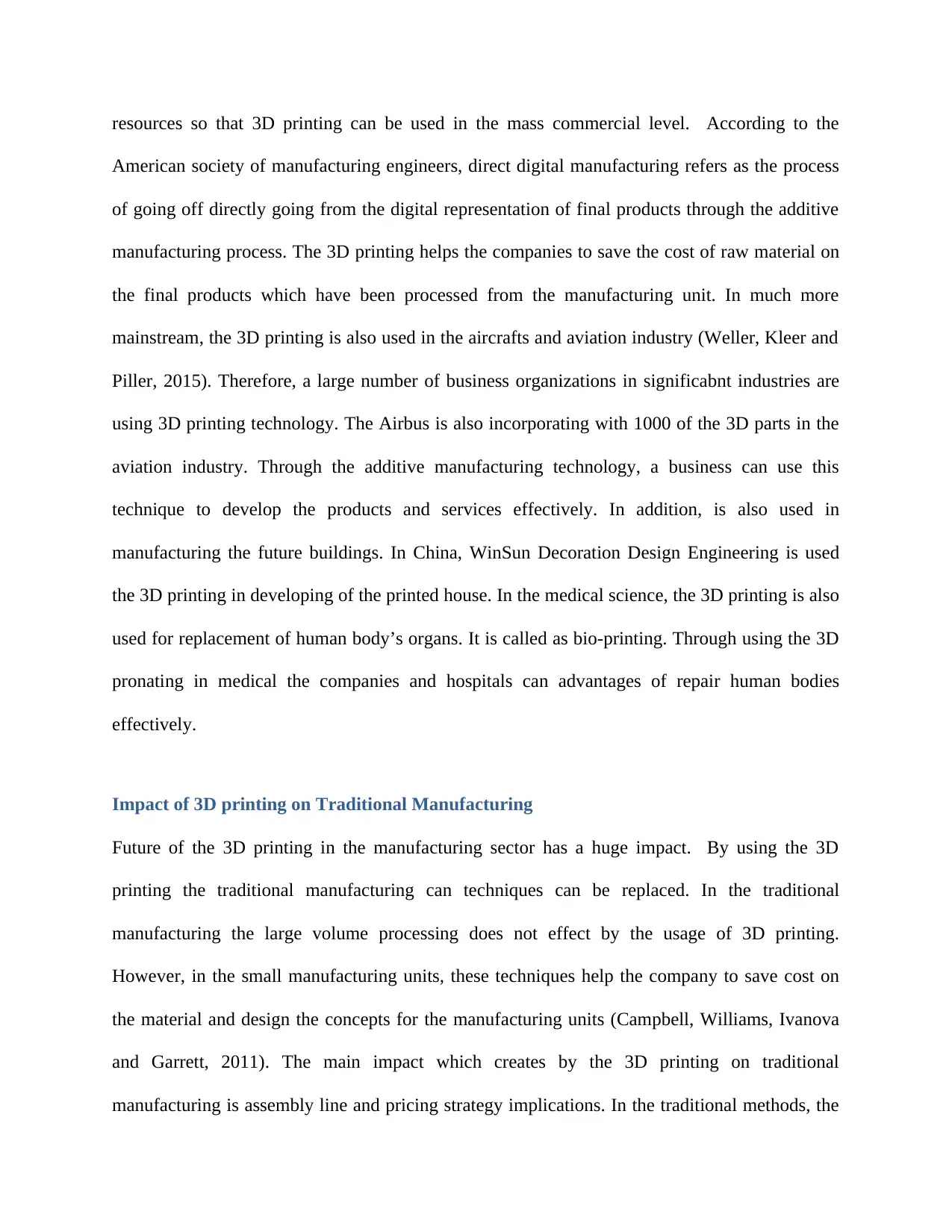
resources so that 3D printing can be used in the mass commercial level. According to the
American society of manufacturing engineers, direct digital manufacturing refers as the process
of going off directly going from the digital representation of final products through the additive
manufacturing process. The 3D printing helps the companies to save the cost of raw material on
the final products which have been processed from the manufacturing unit. In much more
mainstream, the 3D printing is also used in the aircrafts and aviation industry (Weller, Kleer and
Piller, 2015). Therefore, a large number of business organizations in significabnt industries are
using 3D printing technology. The Airbus is also incorporating with 1000 of the 3D parts in the
aviation industry. Through the additive manufacturing technology, a business can use this
technique to develop the products and services effectively. In addition, is also used in
manufacturing the future buildings. In China, WinSun Decoration Design Engineering is used
the 3D printing in developing of the printed house. In the medical science, the 3D printing is also
used for replacement of human body’s organs. It is called as bio-printing. Through using the 3D
pronating in medical the companies and hospitals can advantages of repair human bodies
effectively.
Impact of 3D printing on Traditional Manufacturing
Future of the 3D printing in the manufacturing sector has a huge impact. By using the 3D
printing the traditional manufacturing can techniques can be replaced. In the traditional
manufacturing the large volume processing does not effect by the usage of 3D printing.
However, in the small manufacturing units, these techniques help the company to save cost on
the material and design the concepts for the manufacturing units (Campbell, Williams, Ivanova
and Garrett, 2011). The main impact which creates by the 3D printing on traditional
manufacturing is assembly line and pricing strategy implications. In the traditional methods, the
American society of manufacturing engineers, direct digital manufacturing refers as the process
of going off directly going from the digital representation of final products through the additive
manufacturing process. The 3D printing helps the companies to save the cost of raw material on
the final products which have been processed from the manufacturing unit. In much more
mainstream, the 3D printing is also used in the aircrafts and aviation industry (Weller, Kleer and
Piller, 2015). Therefore, a large number of business organizations in significabnt industries are
using 3D printing technology. The Airbus is also incorporating with 1000 of the 3D parts in the
aviation industry. Through the additive manufacturing technology, a business can use this
technique to develop the products and services effectively. In addition, is also used in
manufacturing the future buildings. In China, WinSun Decoration Design Engineering is used
the 3D printing in developing of the printed house. In the medical science, the 3D printing is also
used for replacement of human body’s organs. It is called as bio-printing. Through using the 3D
pronating in medical the companies and hospitals can advantages of repair human bodies
effectively.
Impact of 3D printing on Traditional Manufacturing
Future of the 3D printing in the manufacturing sector has a huge impact. By using the 3D
printing the traditional manufacturing can techniques can be replaced. In the traditional
manufacturing the large volume processing does not effect by the usage of 3D printing.
However, in the small manufacturing units, these techniques help the company to save cost on
the material and design the concepts for the manufacturing units (Campbell, Williams, Ivanova
and Garrett, 2011). The main impact which creates by the 3D printing on traditional
manufacturing is assembly line and pricing strategy implications. In the traditional methods, the
Paraphrase This Document
Need a fresh take? Get an instant paraphrase of this document with our AI Paraphraser
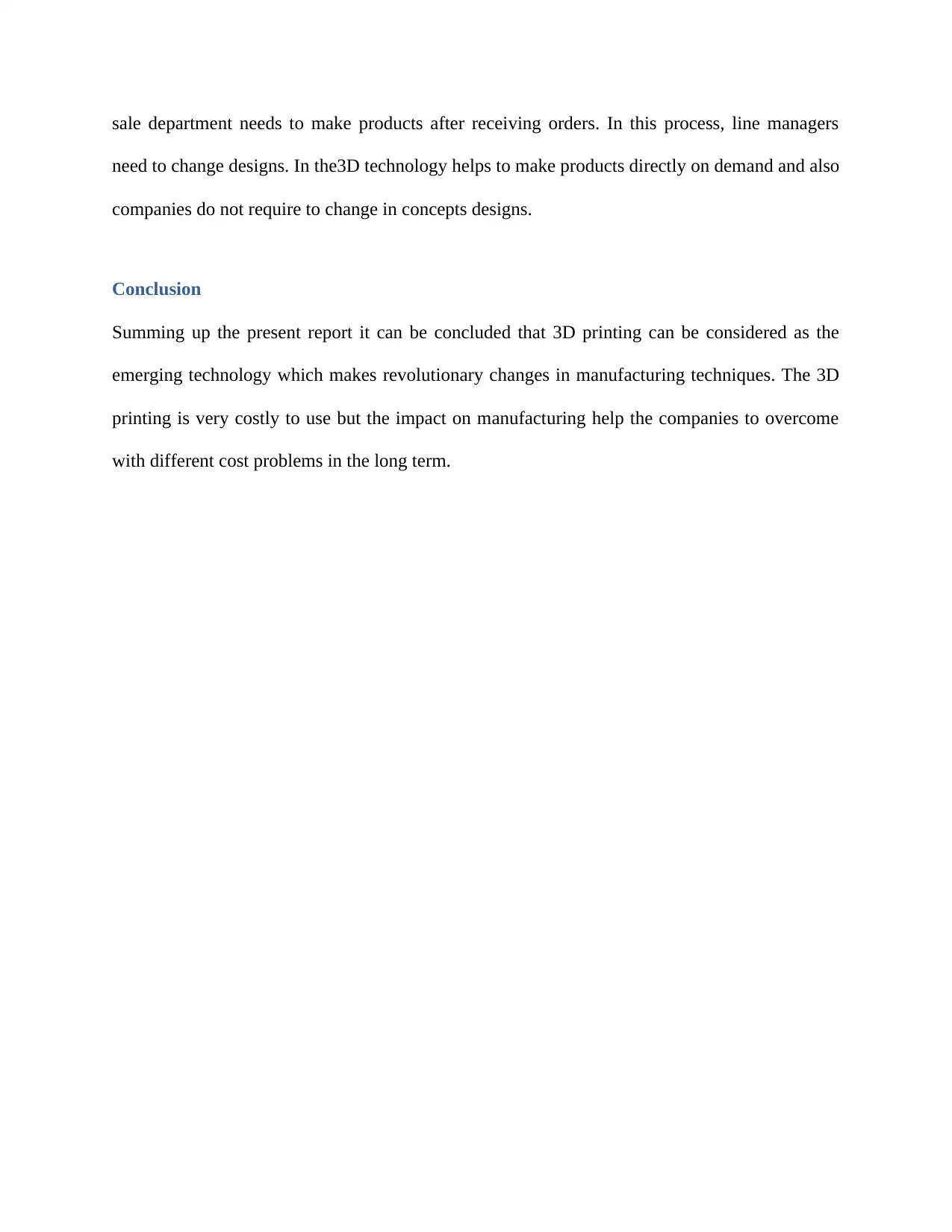
sale department needs to make products after receiving orders. In this process, line managers
need to change designs. In the3D technology helps to make products directly on demand and also
companies do not require to change in concepts designs.
Conclusion
Summing up the present report it can be concluded that 3D printing can be considered as the
emerging technology which makes revolutionary changes in manufacturing techniques. The 3D
printing is very costly to use but the impact on manufacturing help the companies to overcome
with different cost problems in the long term.
need to change designs. In the3D technology helps to make products directly on demand and also
companies do not require to change in concepts designs.
Conclusion
Summing up the present report it can be concluded that 3D printing can be considered as the
emerging technology which makes revolutionary changes in manufacturing techniques. The 3D
printing is very costly to use but the impact on manufacturing help the companies to overcome
with different cost problems in the long term.
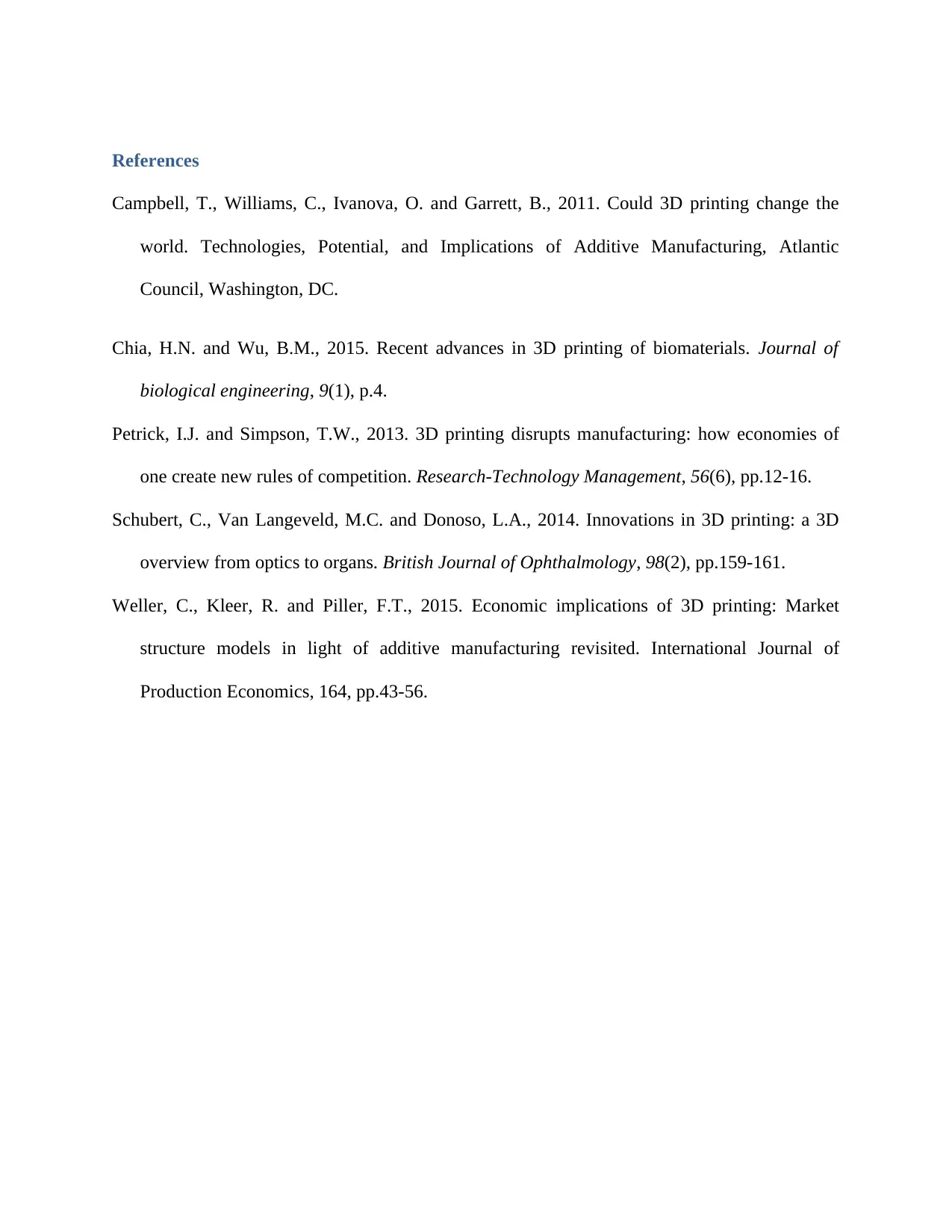
References
Campbell, T., Williams, C., Ivanova, O. and Garrett, B., 2011. Could 3D printing change the
world. Technologies, Potential, and Implications of Additive Manufacturing, Atlantic
Council, Washington, DC.
Chia, H.N. and Wu, B.M., 2015. Recent advances in 3D printing of biomaterials. Journal of
biological engineering, 9(1), p.4.
Petrick, I.J. and Simpson, T.W., 2013. 3D printing disrupts manufacturing: how economies of
one create new rules of competition. Research-Technology Management, 56(6), pp.12-16.
Schubert, C., Van Langeveld, M.C. and Donoso, L.A., 2014. Innovations in 3D printing: a 3D
overview from optics to organs. British Journal of Ophthalmology, 98(2), pp.159-161.
Weller, C., Kleer, R. and Piller, F.T., 2015. Economic implications of 3D printing: Market
structure models in light of additive manufacturing revisited. International Journal of
Production Economics, 164, pp.43-56.
Campbell, T., Williams, C., Ivanova, O. and Garrett, B., 2011. Could 3D printing change the
world. Technologies, Potential, and Implications of Additive Manufacturing, Atlantic
Council, Washington, DC.
Chia, H.N. and Wu, B.M., 2015. Recent advances in 3D printing of biomaterials. Journal of
biological engineering, 9(1), p.4.
Petrick, I.J. and Simpson, T.W., 2013. 3D printing disrupts manufacturing: how economies of
one create new rules of competition. Research-Technology Management, 56(6), pp.12-16.
Schubert, C., Van Langeveld, M.C. and Donoso, L.A., 2014. Innovations in 3D printing: a 3D
overview from optics to organs. British Journal of Ophthalmology, 98(2), pp.159-161.
Weller, C., Kleer, R. and Piller, F.T., 2015. Economic implications of 3D printing: Market
structure models in light of additive manufacturing revisited. International Journal of
Production Economics, 164, pp.43-56.
⊘ This is a preview!⊘
Do you want full access?
Subscribe today to unlock all pages.

Trusted by 1+ million students worldwide
1 out of 9
Related Documents
Your All-in-One AI-Powered Toolkit for Academic Success.
+13062052269
info@desklib.com
Available 24*7 on WhatsApp / Email
![[object Object]](/_next/static/media/star-bottom.7253800d.svg)
Unlock your academic potential
Copyright © 2020–2025 A2Z Services. All Rights Reserved. Developed and managed by ZUCOL.





